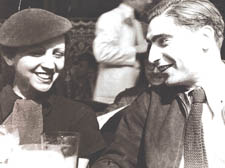|
|
 |
| |

Gerda Taro – professional name of Gerta Pohorylle – with her lover Andrei Friedmann, more famously known as Robert Capa. Photographed by Fred Stein in Paris in 1935 |
Photographers who fought to tell a war story
Gerda Taro was killed in 1937 as she attempted to take pictures from the frontline of the Spanish Civil War.
A new exhibition at the Barbican reflects her photo-journalistic heroics alongside the work of Robert Capa, writes Dan Carrier
SHE had crawled on her belly across fields and through ditches as shells flew overhead and bullets whistled past her.
Other war correspondents had withdrawn from the frontline near the Spanish town of Brunete. Gerda Taro, armed with her camera, agreed it was critical – but that was where you had to be if you wanted to truly document the horror of war.
July, 1937, as Franco’s forces met Republican soldiers desperately defending the town, Gerda was there taking pictures and filming the attack.
German Heinkel and Stuka aircraft machine-gunned and bombed the roads which the Republican soldiers were retreating along.
Taro could see she was in the midst of it. With other comrades she found a road leading to the village of Villaneuva and managed to drag a number of wounded fighters on to a tank to take them to safety.
Then she met a car driven by republican officer General Walter – she hopped on the running board, hoping it would take her to safety.
Instead, a Republican tank driven by a novice struck Gerda, throwing her from the car.
Medics scooped her up, but the brave 27-year-old died hours later, and would go down in history as the first female war correspondent to be killed covering a conflict.
Gerda’s pictures, the subject of a major new exhibition at the Barbican (and displayed alongside those of her great love, Robert Capa) reveal not only her incredible bravery in getting at the heart of battle, but her eye for an image.
Her death was widely mourned. Tens of thousands of people turned out in Paris to pay their respects and streets were renamed in her honour.
Taro – real name Gerta Pohorylle – was born in Stuttgart, Germany, the daughter of Polish Jewish parents. She had fled to Paris in 1933 after being arrested for taking part in an anti-Nazi demonstration and it was here she met Andrei Friedmann, the Hungarian émigré struggling to earn a living as a photojournalist.
The pair quickly became both colleagues and lovers, and it was Gerda who decided to act as Friedmann’s agent. In order to create a buzz among the newspaper and magazine editors to whom she hoped to sell her own and her lover’s work, she suggested they invent a new persona for the man behind the camera.
They were worried about the anti-semitism in Paris at the time. Hitting upon the popularity of American film director Frank Capra – who Freidmann greatly admired – they decided to send letters to the major magazines saying pictures by the “famous American photographer, Robert Capa” would be available for a limited time.
It is easy to forget now, with our rolling news coverage provided by reporters using satellite phones and hi-tech digital video cameras, that war reporting in the 1930s was a very different affair. There had been a boom in the wireless news bulletin but visually the public would have had to rely on the newsreels shown at the cinemas. The time between the film being shot and shown meant the reports were hopelessly dated and unable to quench the thirst for news.
With the Spanish Civil War occupying the thoughts of the Continent, editors wanted images from people on the ground.
Gerda Taro and Robert Capa wanted to bear witness. Solid anti-fascists, they saw the spread of information about the terrible effect the war was having on civilians as vital to stemming the darkness of Nazism seeping through Europe.
The war brought women into the frontline. It also brought female foreign correspondents into Spain. Martha Gellhorn saw Madrid under siege, and fell in love with Ernest Hemingway while she watched shells fall on their hotel. Kitty Bowler, who was from the same St Louis university as Gellhorn, also came to report what she found.
Gerda’s talent as a photographer, allied with her bravery under fire, earned her the respect of the soldiers she was covering. They mourned her death across Spain.
The pair are tragic figures: Capa never truly got over the loss of his great love, and was to die in Indo-China in 1954, killed by a landmine.
This powerful exhibition brings alive the work of two of the 20th century’s bravest war photographers, and is the product a tragic romance torn to pieces by the dark political games of the 1930s.
 |
| |
|
 |
 |
|
 |
|



